A Delhi court discharged former JNU student Umar Khalid and United Against Hate founder Khalid Saifi in a northeast Delhi riots case on 3 December. This case was about an incident of arson at a parking lot. The court noted that they were facing similar allegations of criminal conspiracy in an Unlawful Activities Prevention Act (UAPA) case.
What was the case against Umar Khalid and Khalid Saifi?
The police had registered this case on the basis of constable Sangram Singh’s complaint. The cop was on duty when riots broke out near former AAP councillor Tahir Hussain’s house on 24 February 2020.
The constable took shelter near a parking lot when a Muslim mob broke open the shutters of the parking lot and set the parked vehicles on fire.
Delhi Police filed the charge sheet in this case on 2 June against 15 individuals, making Saifi an accused in a supplementary charge sheet filed on 3 September 2020. Umar Khalid’s name appeared in the third supplementary charge sheet that the police filed on 26 December that year.
Police arrested Umar Khalid and Khalid Saifi in connection with the case on the allegation of a criminal conspiracy, accusing Saifi of arranging a meeting between Tahir and Umar on 8 January 2020 at Shaheen Bagh where they allegedly planned to instigate crowds for a riot by blocking roads during the anti-CAA protests.
Did you miss this? 10 legal reasons Umar Khalid was denied bail
Delhi Police accused Saifi of involvement in financial transactions with Tahir in January 2020 in preparation for riots. Police accused Umar of meeting with the then-AAP councillor in preparation for the riots.
Police booked both men on the basis of Tahir Hussain’s disclosure. Their lawyers argue that there was no clarity on the nature of this meeting at Shaheen Bagh.
Why were they discharged by the court?
Fire at the parking lot is not the only case against the duo. Additional Sessions Judge Pulastya Pramchala discharged the two accused in one of the cases, noting that they were facing similar allegations in a separate case, which is under the UAPA dealing with the conspiracy to commit riots in Delhi.
The court called the UAPA case “a larger conspiracy under which several smaller conspiracies are hatched”. “Planning to ignite a communal riot at a large level and taking steps for the prosecution of such plan, could be an umbrella conspiracy and participants to this conspiracy may or may not be part of each smaller conspiracy and vice versa,” the court said.
The court said a smaller conspiracy would mean smaller plans made to pursue the objectives of an umbrella conspiracy. It noted that these smaller plans were made to execute incidents like riots involving other persons.
Besides Saifi and Umar, the court has discharged three other men who were accused of harbouring Tahir Hussain while he was on the run, noting that they were arrested on the basis of the former AAP councillor’s statement of disclosure, which was inadmissible as evidence.
The UAPA case has 15 accused including student activists like Sharjeel Imam, Devangana Kalita, Natasha Narwal, Gulfisha Fatima and Safoora Zargar among others. The special cell accused them of conspiring to initiate riots in Delhi under the garb of anti-CAA protests during the visit of then-US President Donald Trump.
Charges against Tahir Hussain
The court framed charges against Hussain and 11 others under Sections 120B (punishment for criminal conspiracy), 153A (Punishment for knowingly carrying arms in any procession), 436 (Mischief by fire or explosive substance with intent to destroy a house, etc) and several sections of the IPC that apply to rioting.
Most read: Tahir Hussain trail leads to Kejriwal, Sisodia
Charging the former AAP councillor, the court mostly stuck to the allegations of witnesses in the parking lot case. It said that even though this was not a case where the evidence showed the presence of any named accused, it was not necessary for an accused to be physically present to achieve their common objective.
By the same logic, the court said that it was not required that Tahir should physically visit the said parking along with the mob.
“It is sufficient to show that he was a member of that mob and the role imputed to him is to instigate the mob to attack, to guide and to facilitate such (an) attack, in order to accomplish the common object of this unlawful assembly,” the court said.



You must log in to post a comment.